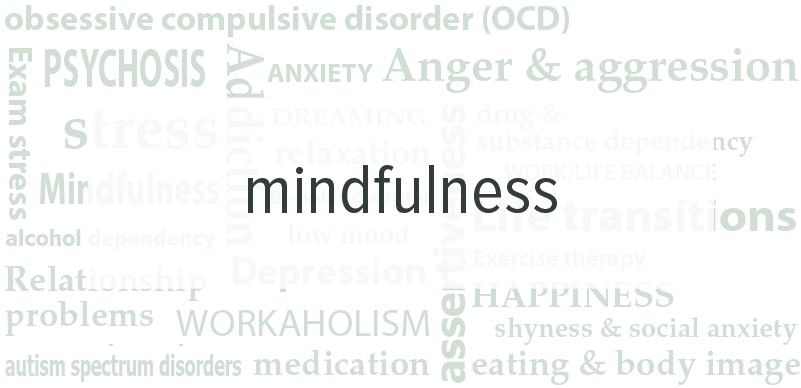Mindfulness
Mindfulness is about living in the present. By becoming more mindful you will increase your awareness of your thoughts and feelings and will notice that your mind is never still – it is constantly thinking and making up stories.
How mindfulness can help you
Becoming aware of your own thoughts and feelings allows you to accept them. If you are mindful, you will accept your thoughts and feelings for what they are and not give excessive importance to them. For example, you may think thoughts such as “that person doesn’t like me” or “I didn’t make a good impression” or “everything is getting on top of me”. However, a mindful person will acknowledge these thoughts as just thoughts and let them go.
Negative feelings result from negative thoughts, so if you spend a lot of time mulling over negative past experiences or think about negative things that may happen in the future, you may begin to feel angry, sad, guilty, anxious or regretful. Many people believe the past runs their life. However, the past is gone, it is only your thoughts about the past that remain. They are simply memories. This doesn’t mean that you should pretend the past never happened, but rather that you should accept your thoughts about the past as harmless memories travelling through your mind. They don’t need consideration, just acceptance. Understanding our thoughts can give us the freedom to become less preoccupied with, and give less meaning to them.
Mindfulness and happiness
Happiness is simple – no matter what has happened in the distant or recent past, happiness lies in the present. This can be a hard concept for humans to master, but with practise you will realise that thoughts do not reflect reality. Your present mood is affected by thoughts of things outwith the moment. Once you have grasped this concept, you will be a more peaceful person.
It is, of course, not possible to stop thinking about the past altogether. However it is best to try and live in the moment as much as possible. For example, when out walking you may be mindful of the sensations in your feet, the beauty of your surroundings, or the sounds of trees rustling in the wind. You may also be mindful of your thoughts at that moment. When we understand the link between our experience and our thoughts, we can change negative perceptions such as “this is boring – I wish I was already home so I can get started on something” to “the sun is beating down – the trees are softly moving in the wind – the architecture is beautiful”. In this example, you can see that something simple such as walking does not have to be judged negatively as “boring” or “time-wasting” because it is an objective activity which you can subjectively interpret in any way.
How to apply mindfulness
To become more mindful you should try to be more aware of your thoughts and bring them back to the present moment. Concentrate on your surroundings rather than on what is going on in your head. Once you begin to become more mindful, you will probably notice hundreds of fleeting thoughts relating to the past and future. By consciously returning your focus to the present over a long period, the process will become more natural and automatic to you. You will learn to concentrate on the here and now rather than becoming caught up with thoughts that may result in a bad mood.
When you become annoyed, frustrated, or upset you will probably find that your mind has wandered from the present. The next time you feel this way, ask yourself what you have been thinking about, then try to refocus on the present.
For example: Stop reading for a moment and think about where you are now. You are sitting comfortably reading a book of your choice. You are not concerned with past or future worries. You are simply sitting reading. Then think about all the tasks you still have to do this week. As you think, you will notice your peace of mind slipping. The only thing that has changed to make this happen is your thoughts. Nothing else has changed.
This exercise demonstrates how your thoughts can quickly change your mood. You cannot suppress your thoughts, but by being aware of them, you can stop them from developing and bring yourself back to your naturally contented state in the present moment.
It is difficult to try to dismiss thoughts if something significant has happened. However while you are feeling low, it can be helpful to acknowledge that your thoughts are likely to be unhelpful and negative. If you can accept that this period will pass, it will become easier to deal with.
Self help
- The Happiness Trap by Russ Harris (accompanying website and free resources at www.thehappinesstrap.com)
‘A ground breaking book that offers new techniques using mindfulness skills to enable you to experience and full and happy life and to overcome depression and anxiety.’ This such an easy read and offers a really different perspective on psychological distress based on Acceptance & Commitment Therapy (ACT). If you feel inspired by this approach and want to learn more, the free resources and website are also very helpful. - Wherever you go, there you are by Jon Kabat-Zinn
A book that provides a simple guide to mindfulness practice in everyday life both for beginners and those who wish to deepen their practice. If this is an approach that you enjoy it is also possible to buy CDs that can provide guided mindfulness support. - A Path With Heart by Jack Kornfield
A mature, broad and reassuringly structured introduction to meditation and walking the spiritual path - Download First Psychology's Mindfulness booklet for more about mindfulness and ways to become more mindful.
More information
Feel free to contact us to ask about psychological therapies available at First Psychology Borders that use mindfulness-based techniques.





